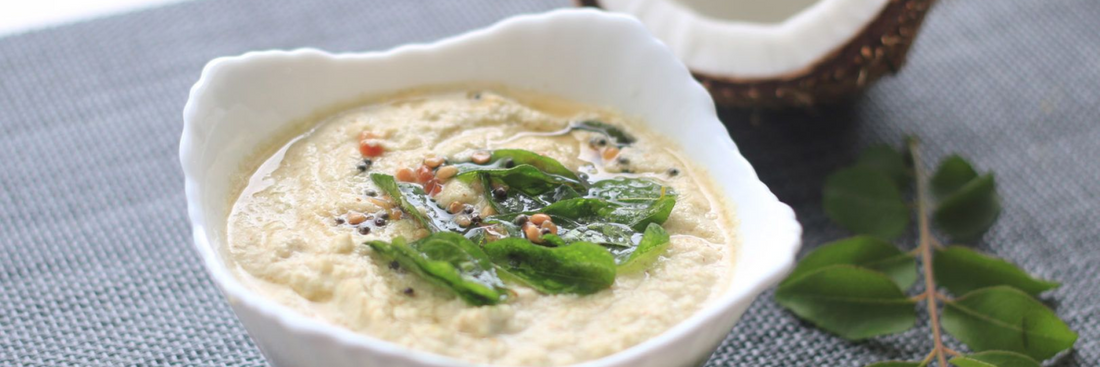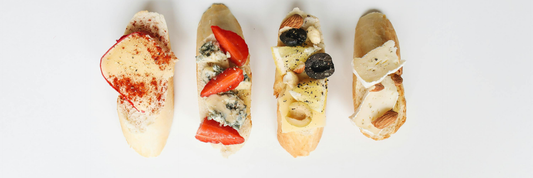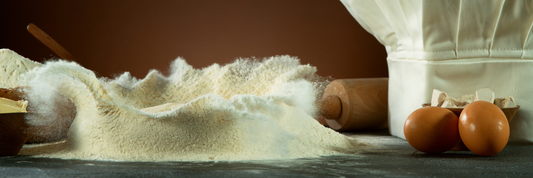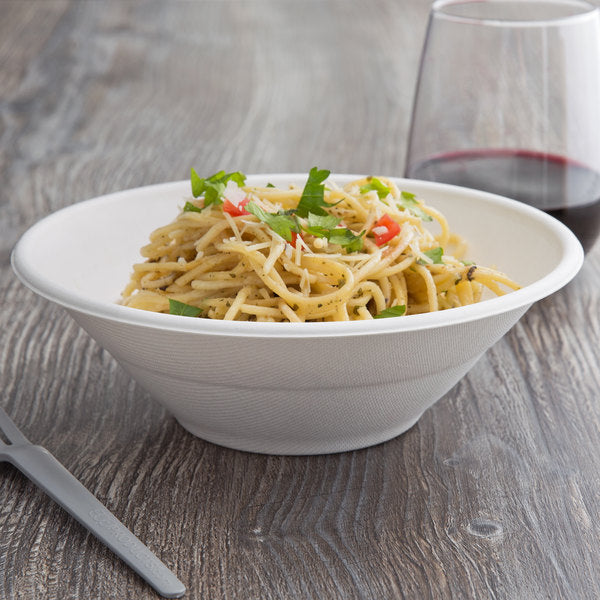What is Coconut Chutney?
Coconut chutney is an essential condiment that plays a pivotal role in South Indian cuisine. Its origins can be traced back centuries, deeply rooted in the culinary traditions of South India, where coconuts are abundantly harvested. This chutney exemplifies the region's love for fresh ingredients and emphasizes the use of coconut not just as a food item, but as a staple in various dishes.
The versatility of coconut chutney is remarkable; it can be prepared in numerous ways to cater to different tastes and preferences. From basic recipes to more elaborate versions, the adaptability of this chutney enables it to complement a wide array of dishes, establishing itself as a beloved side dish from breakfast to dinner.
In this guide, we’ll explore the different types of coconut chutney, what makes each special, and how you can pair them with your favorite dishes to bring authentic South Indian flavor into every meal.
Chutney: What Is It, Common Chutney Recipes & What Is Chutney Served With?
Popular Types of Coconut Chutney

Coconut chutney’s charm lies in its versatility, with numerous variations suited to different tastes and dishes. Each type brings a unique flavor profile, texture, and aroma, making them ideal accompaniments for a wide range of meals.
White Coconut Chutney
This is the classic form of coconut chutney, made with freshly grated coconut, roasted chana dal, green chili, and a hint of ginger. The roasted chana dal lends a subtle earthiness and thickness, balancing the natural sweetness of coconut. White coconut chutney is a must-have side with South Indian staples such as idli, dosa, and vada. Its creamy, mildly spicy taste enhances these dishes perfectly, making breakfast flavorful and satisfying. You can find more on traditional chutney uses and pairings in our extensive South Indian cuisine posts.
Red Coconut Chutney
For those who love a bold and spicy kick, red coconut chutney combines dry red chilies, garlic, and onions with coconut. This chutney offers a fiery warmth that complements dosas and vadas exceptionally well, turning simple breakfasts and snacks into vibrant flavor experiences. Its bold flavors echo the dynamic tastes found in our How To Make Green Chutney For Sandwich, Dosa, Chaat blog, where spice and freshness meet in perfect harmony.
Coconut Chutney with Coriander and Mint
Adding fresh coriander and mint to coconut chutney creates a refreshing, herbaceous variant. The lemon juice often included adds a bright zing that lifts the entire chutney. This version works beautifully with lighter snacks, such as pakoras or as part of a breakfast spread. The cooling effect of mint pairs well with the occasional heat of green chilies. For more herb-inspired chutney recipes, explore our guide on How to Make Mango Chutney and discover natural flavor enhancers that complement tropical fruits.
Tomato Coconut Chutney
Tomatoes bring a pleasant tang and natural sweetness when combined with coconut. This chutney variant is perfect as a spread for sandwiches or as a dip for baked goods and soft rolls, offering a fusion of creamy and tangy flavors. Its versatility sets it apart and broadens the possibilities for chutney uses beyond traditional South Indian dishes. For detailed recipes on tomato-based chutneys, see How to Make Tomato Chutney.
Peanut Coconut Chutney

The addition of roasted peanuts intensifies the texture, making the chutney thicker and creamier with an engaging crunch. Tamarind adds a subtle tang that balances the richness, making this chutney an excellent pairing for fried snacks and pakoras. This blend is highly favored for its satisfying mouthfeel and complex flavor. To explore more peanut-based chutneys and their ideal pairings, check relevant recipes linked within our snack and street food guides on Kimecopak.ca.
Coconut Chutney with Ginger
Ginger adds a warm and zesty note to the basic coconut chutney, enhancing flavor complexity while aiding digestion. This variant is especially comforting and suitable as a post-meal condiment, aiding in digestion and adding a subtle spicy undertone. You can pair this chutney with dishes that focus on digestive health or lighter meals seeking a flavorful kick.
Coconut Chutney with Onion
Sautéed onions lend a mild sweetness and savoriness to coconut chutney, creating a balanced and pleasant taste. This variation is popular as an accompaniment to dosas and idlis, adding a fragrant dimension to traditional South Indian breakfasts. The unique, gently sweet flavor elevates simple meals into delicious experiences.
Tips for Storing and Using Coconut Chutney
Coconut chutney is a versatile condiment that enhances the flavor of many dishes, from dosas to idlis. Proper storage is key to maintaining its freshness and flavor, allowing you to enjoy it in multiple meals.
How to Store in the Fridge and Freezer
- Refrigeration: Store coconut chutney in an airtight container in the refrigerator. It can typically last for about 4 to 7 days when kept at a consistent temperature. Be sure to use a clean spoon each time to avoid contamination.
- Freezing: For longer storage, you can freeze coconut chutney. Divide it into smaller portions using ice cube trays or silicone molds. Once frozen, transfer the chutney cubes to a freezer-safe bag or container. This method allows you to defrost only what you need without thawing the whole batch, and it can last up to three months in the freezer.
Optimal Shelf Life
To maximize the freshness of coconut chutney, it's essential to keep it sealed and chilled. When refrigerated, look out for changes in color or an off smell, which may indicate spoilage. If frozen, it's best to label your containers with the date to monitor its shelf life easily.
Pairing with Different Dishes
Coconut chutney is commonly paired with various Indian dishes, but its versatility expands beyond traditional usage:
- Idlis and Dosas: These South Indian staples are typically served with coconut chutney for breakfast or snacks.
- Rice Dishes: Coconut chutney complements rice dishes like coconut rice or lemon rice nicely, adding a creamy texture.
- Sandwiches and Wraps: Use coconut chutney as a spread in sandwiches or wraps for a unique twist on these favorites.
- Vegetable Pakoras: Serve coconut chutney as a dipping sauce for crispy pakoras, enhancing their flavor profile.
Health Benefits of Coconut Chutney

- Rich Source of Healthy Fats: Coconut contains medium-chain triglycerides (MCTs), which are easier to digest and provide a quick energy source. MCTs are linked to improved metabolism and potential support for weight management.
- High in Dietary Fiber: The grated coconut used in chutney is rich in dietary fiber, which aids digestion, promotes regular bowel movements, and helps maintain gut health. Fiber also contributes to a feeling of fullness, which can assist in controlling appetite.
- Supports Digestive Health: Ingredients commonly used in coconut chutney such as green chilies, ginger, and coriander have digestive properties. They stimulate the digestive system, promote enzyme activity, and can help reduce bloating and indigestion.
- Boosts Immunity: Coconut has antimicrobial properties due to the presence of lauric acid, which can help fight bacteria, viruses, and fungi. Alongside antioxidant-rich spices and herbs in the chutney, this can support overall immune function.
- Anti-inflammatory Effects: Spices like ginger and coriander in coconut chutney possess anti-inflammatory compounds that may help reduce inflammation, contributing to better health and potentially alleviating symptoms in inflammatory conditions.
- Nutrient-Rich: Coconut chutney offers essential minerals such as manganese, copper, and selenium sourced from coconut and other fresh ingredients. These trace minerals are vital for various bodily functions, including antioxidant defense and bone health.
By incorporating coconut chutney into your diet, you enjoy not only a burst of authentic South Indian flavor but also these diverse health benefits.
FAQs about Coconut Chutney
How long can coconut chutney be stored?
When kept in an airtight container in the refrigerator, coconut chutney can last up to 4–7 days. For longer storage, it can be frozen in small portions for up to three months.
What dishes go best with coconut chutney?
Coconut chutney pairs perfectly with South Indian staples like idli, dosa, vada, and upma. It also works wonderfully as a dip for snacks or a spread for sandwiches and wraps.
Is coconut chutney healthy?
Yes. Coconut chutney contains healthy fats, fiber, and essential minerals. Its ingredients—like ginger, coriander, and green chilies also aid digestion and boost immunity.
Can I make coconut chutney without coconut?
If coconut isn’t available, you can substitute it with roasted peanuts, cashews, or soaked poha (flattened rice) to mimic the creamy texture and still enjoy a similar flavor.
How do I prevent coconut chutney from turning sour?
Always store it in a cool, airtight container, use a clean spoon when serving, and avoid keeping it at room temperature for too long. Adding a bit of tamarind or lemon juice can also help extend its freshness.
Conclusion
Coconut chutney is more than just a side dish, it’s a flavorful symbol of South Indian culinary tradition. Whether you prefer the mild creaminess of white chutney, the spicy depth of red chutney, or the refreshing twist of mint and coriander, each variation brings out the best in your meals.
By experimenting with different ingredients and pairings, you can discover how versatile this simple condiment truly is. Try it with dosas, idlis, pakoras, or even as a spread in modern fusion dishes. With its rich nutrients, fresh taste, and endless adaptability, coconut chutney deserves a regular spot in every kitchen.







